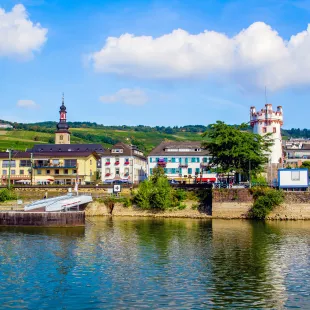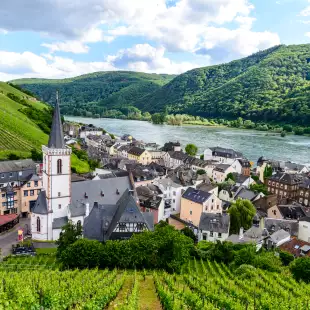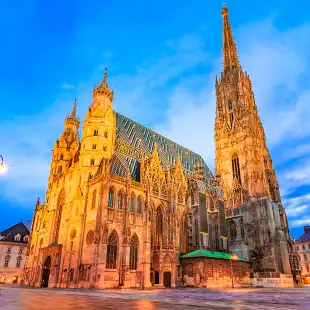What to Expect Along the Rhine-Main-Danube Canal

Discover the history along the Rhine-Main-Danube canal, facts about the European waterway and the best river cruises to see the canal.
by Sue Bryant
Watching heavily laden barges chug by as you relax on the deck of your European river cruiser is intriguing; where they come from, what cargo they’re carrying, what it must be like to live on board. What’s even more fascinating, though, is the fact that these barges, as well as river cruisers, can sail right across continental Europe along a watery superhighway, more than 2,200 miles long, connecting the North Sea to the Black Sea.
This hasn’t always been the case; in fact, it wasn’t until 1992 that the opening of the 106-mile made this voyage possible, linking the two great European river systems of the Rhine and the Danube German rivers. Ships could now sail from the mouth of the Rhine, near Rotterdam, to the Danube delta in Romania.

The canal is one of Europe’s largest-ever transport engineering projects; it’s more than twice the length of the Panama Canal and cost an eye-watering 1.98 billion Euros to build. There’s far more to it than an artificial waterway linking two rivers. Bamberg, where the canal leaves the Main, is 352 feet lower than Kelheim, where it joins the Danube and in between is the small matter of the continental divide, the ridge of forested hills that forms part of the European watershed, or the drainage basins for Rhine and Danube river systems.
The canal has to carry ships upwards in steps, over the top of the divide and down the other side and as such, its statistics are impressive. Cutting through rural Bavaria, the waterway rises a height of 1,332 feet through 16 sets of locks, the deepest of which will raise or lower a vessel 78 feet. Of course, there are other locks along the way – 68 in total if you sail from Amsterdam to Budapest – but those along the canal are the deepest and the most impressive. It’s because of the restrictions of all these locks, and the low bridges, that European river cruisers have to be the shape they are – long, low and skinny.
The concept of digging a canal to connect the Danube and the Main dates right back to 793 AD, when Emperor Charlemagne ordered work to be started on the ‘Fossa Carolina’ trench, dealing ambitiously with the altitude changes via a series of ponds, as locks and pumps had not yet been invented. Constant rain and, eventually, flooding of the trench meant that the project failed although a section called Karlsgraben still exists. A later version of the canal spanned part of today’s distance but was damaged in World War 2 and fell into disrepair in the 1950s.
Two of Riviera Travel’s itineraries take you along the Rhine-Main-Danube canal: Cruise the Heart of Europe, between Cologne and Budapest; and Medieval Germany, between Frankfurt and Nuremberg. Much of the time, it’s almost impossible to imagine you’re sailing a man-made waterway, so bucolic are the scenes along its course. Millions were spent at the time of construction on creating nature reserves along the canal and today, water meadows, farmland and thickly wooded hills guarded by castles create a backdrop, with locals cycling and walking dogs along the banks. Near the town of Riedenburg, you can see three castles from the ship, Rosenburg, Rabenstein and Tachenstein, while at Nusshausen, you’ll sail past a dramatic limestone spur on which Prunn Castle, which dates back to the 11th century, is perched, for all the world to see like something out of a movie set.
The reminder, of course, is the constant succession of locks. While the locks themselves mean a lot of stop-start on a river cruise, they are fascinating, and often a reason for passengers to gather on deck to watch the spectacle, even at night. It’s certainly a strange experience; going up, you start off in a dark, dank chamber, the walls just inches from the sides of the ship, rising up towards the daylight. Going the other way, there’s a certain sinking feeling as the water level drops and the sheer walls block out the light. Watching the captain and crew at work, nudging the ship in and out of the locks, is mesmerising.
There’s much to look out for along the path of the canal. Between the Hipoltstein and Bachhausen locks, for example, you’ll be at 1,332 feet above sea level, the highest point on Earth reached by a commercial ship coming from sea level, marked by a minimalist sculpture of a wall of pale granite.
You’ll also sail over a series of amazing aqueducts. On these stretches, you’re cruising over the top of roads and fields, which is an extraordinary sensation. You can look out for them by observing the canal kilometre markers, which are a useful guide – they’re spaced along the banks at one-kilometre intervals. One aqueduct takes you over the Regnitz River after 61.9 km, with another over the Schwarzach River at 79 km.
The towns along the canal are beautiful, too, offering some of the best-preserved examples of medieval German architecture. In Bamberg, close to where the canal begins, the old, half-timbered town hall sits in the middle of a twin-arched bridge over the river Regnitz, which flows through the town. The cathedral dates back to the 11th century and the narrow streets are lined with Baroque patrician houses. The town has several breweries and is famed for its smoked beer (Rauchbier).

Nuremberg, despite extensive damage in the last war, still retains most of its original city wall, studded with watchtowers, the cobbled streets inside lined with ancient houses and gothic churches.
Wherever your river cruise takes you, this fascinating part of Germany will create a lasting impression.
We hope this has inspired you to take a river cruise along the Rhine-Main-Danube canal. If you have any questions, please do not hesitate to contact us.
Sue Bryant
Sue Bryant is an award-winning journalist specialising in (and addicted to) cruising. She is cruise editor of The Sunday Times and also contributes to magazines and websites worldwide, including Sunday Times Travel Magazine, World of Cruising, Cruise Passenger (Australia), Porthole (USA) and www.cruisecritic.co.uk. Sue lives in London but is often travelling, exploring the world’s rivers and oceans. She has sailed on more than 100 ships over the last 15 years.




























